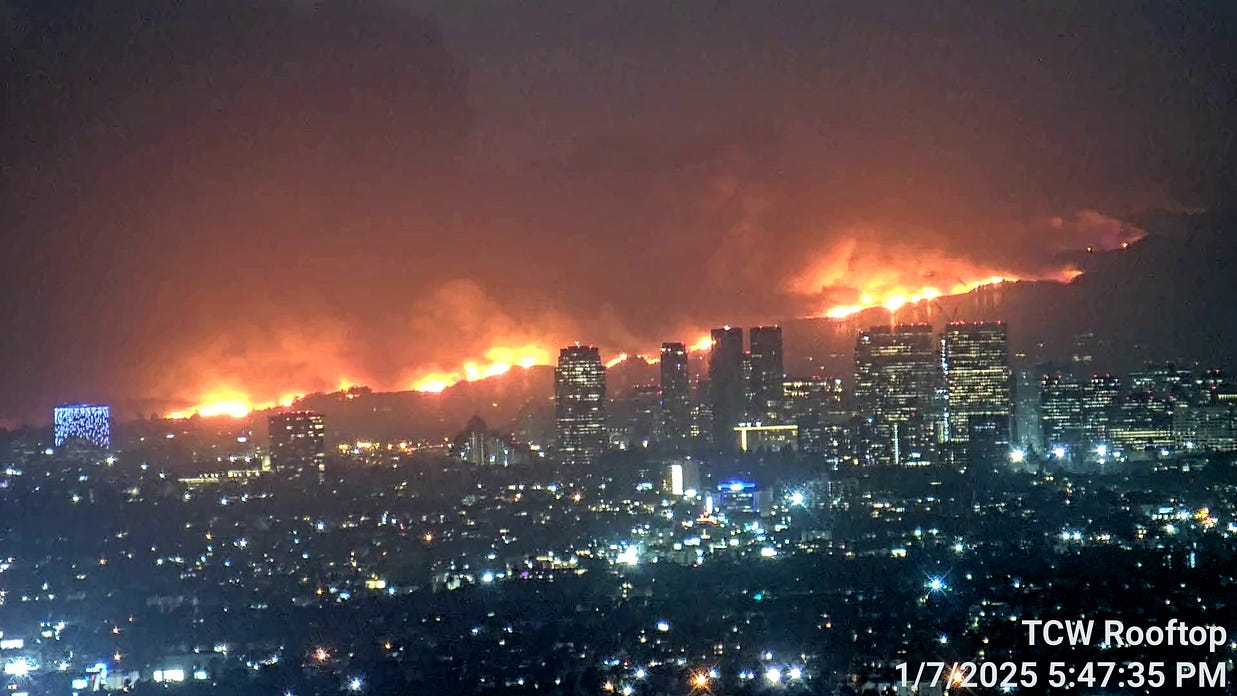Is the Doomsday Clock a Symbolic Warning of Impending Doom or Are There More Compelling Metrics?
Clickbaity stories followed the reset of the Doom Clock — does this have anything to do with our real lives??

Sometimes, the best way to learn our craft is to read. Here’s an off-topic story I enjoyed writing. I learned a lot from it. And I’m suggesting you read it, looking for the things that define my voice and style. Then consider how you define your voice and style.
As a long-time journalist, I looked into the reality of the dire Doomsday Clock stories spamming the internet and media this week. Here’s what I found, including real warnings that it might behoove us to consider.
Imagine the world has a giant bedtime clock. But instead of signaling when to go to sleep, it tells us how close we are to something really terrible happening — like major wars, the planet getting too hot, or other scary stuff.
Breaking News: The Doomsday Clock Moved Closer to Midnight!
In a move that would make even the most laid-back among us break a sweat, the Bulletin of the Atomic Scientists nudged the Doomsday Clock to a hair-raising 89 seconds before midnight — the closest it’s ever been to the proverbial witching hour. One and a half symbolic minutes.
A brief history of metaphorical time
The Bulletin of the Atomic Scientists set the clock to 89 seconds before midnight. Midnight represents the theoretical point of our annihilation. That is one second closer than it was set last year. In 1945 scientists, including Albert Einstein and J. Robert Oppenheimer, founded the Chicago-based nonprofit. They conceived the clock in 1947 during the Cold War tensions following WWII to warn the public about how close humankind was to destroying the world.
By the way, if you’re reading this as bedtime fodder, put it away until tomorrow.
Anyway, the group now includes nine Nobel Laureates. Since its debut in 1947, the Doomsday Clock has served as a barometer for humanity’s proximity to self-inflicted catastrophe. Initially set at a comfortable seven minutes to midnight, it has wavered over the decades, reflecting the world’s fluctuating fortunes.
But never before has it flirted so dangerously with the midnight toll.
“[The factors we considered] were not new in 2024. But we have seen insufficient progress in addressing the key challenges, and in many cases, this is leading to increasingly negative and worrisome effects,” said Daniel Holz, chair of the Bulletin’s Science and Security Board.
Why so close now?
The Bulletin’s decision to advance the clock stems from a confluence of global threats:
Nuclear tensions: Russia’s saber-rattling in Ukraine and its revised nuclear posture have reignited fears of atomic conflict with no resolution in sight and interference from outside actors increasing the turmoil.
Climate change: Despite strides in renewable energy, the planet’s fever shows little sign of breaking, with natural disasters becoming unsettlingly routine. Last year was the hottest in recorded history, according to the U.N. World Meteorological Organization. We are all aware of worsening storms and the escalating impact of wildfires worldwide, for example. You can read more on that here—21st Century Problems: Canadian Wildfire Smoke Is Coming for Us
Artificial intelligence: Unless you live in a quiet cave, you know that the amazing pace of AI infesting every aspect of life, while promising, carries risks if misused or left unchecked. In October 2024, Joe Biden signed an executive order addressing the risks AI poses. Doesn’t matter what you think of which president, some action seems prudent. His successor, Donald Trump, revoked it.
“Experts warn that AI is increasingly disrupting the world’s information ecosystem. AI-fueled disinformation and misinformation will only add to this dysfunction,” Holz said.
The political climate’s role
Current geopolitical dynamics are not slowing the ticking clock. Listen — tick tick tick.
The US, China, and Russia refuse to get a handle on their high-stakes game of geopolitical chess. Trust me, checkmate on any side will not add to our quality of life — if we have a life.
Meanwhile, perpetual hot spots like the Middle East and tensions in East Asia turn the burner up under our existence almost daily. The Ukraine war continues to be Europe’s bloodiest conflict since WWII. Nuclear involvement is not out of the question.
China is still dicking around in Taiwan, and the lunatic in North Korea is upping his insanity. He is currently delighted by seeing a huge fan of his gain control of a world superpower. Something to think about in the dark, for sure.
What’s to be done — how do we slow those ticking hands?
It’s kind of common sense, but the Bulletin suggests some prudent steps.
Diplomatic engagement: Encouraging the major powers to engage in good-faith discussions to address nuclear risks and other global threats.
Climate action: Accelerating efforts to mitigate climate change through policy and innovation. How’s that working for us so far? The US is stepping back from climate change initiatives.
Regulating emerging technologies: Establishing frameworks to ensure the safe development and deployment of AI and other advanced technologies. Three steps back for every step forward right now. Money, power, and fame drive the race to spam AI technology through the universe with little regard for consequences.
A stark warning
Say what you will about the metaphoric nature of the Doomsday Clock. The people at the Bulletin have this to say, not mincing words.
“Continuing on the current path is a form of madness.” — thebulletin.org
Yeah, but does anyone take the Doomsday Clock seriously? A resounding yes! But with a proverbial pinch of salt in many cases. Scientists, especially in fields like nuclear security and climate change, talk about it as a symbolic warning rather than a literal countdown to disaster. It should make people stop and think, Hey, we might want to stop and think a minute before we go blindly on. What if these global problems get out of hand? UM. What if?
Governments and policymakers pay attention to the rhetoric about the clock, but they don’t make decisions based on it, and why would we think they would or should?
Scientists, activists, and parties with agendas use it to push for things like climate action and nuclear disarmament. The media treasures it because Doomsday Clock Almost at Midnight is a dramatically compelling headline to fuel revenue. And it’s a golden opportunity for assigning blame to anyone the media wants to target.
Then we must consider who takes it with the grain of salt and why. Some critics call it too vague. I mean, there’s no actual ticking clock controlling world events, and where’s the hard science behind the analysis?
Pragmatic people argue that the clock metaphor leans toward fearmongering rather than practical solutions. Fair enough. It should be noted, as well, that a lot of regular people either haven’t heard of it at all, or they shrug and go, “Eh, the world always seems to be in trouble.”
Apathy is a world pastime.
So, while the Doomsday Clock is a powerful metaphor for global risks, it’s not a crystal ball. Midnight won’t bring zombies or explosions — just a reminder that we should probably make better choices before things worsen. The clock is based on expert opinions from scientists, policymakers, and security analysts.
We know opinions can represent true facts, and the clock’s specified threats could seriously harm humanity. It has historically reflected big global moments, like the Cold War, nuclear treaties, and climate agreements.
But. For all you cynics and realists, it has to be said that this particular clock doesn’t use a mathematical formula or specific data to set the time. Moving the clock closer to midnight doesn’t mean an actual catastrophe is guaranteed or even necessarily likely.
And that begs the question, “Are there real, factual indicators with scientific backing?”
Compelling alternatives that might get your attention
Mercator Research Institute’s Carbon Clock shows exactly how much CO₂ we can emit before we blow past safe global warming limits — and it updates in real-time. Instead of a vague “midnight,” it calculates an actual deadline.
The Doomsday Report Card (Global Risk Reports) or World Economic Forum’s Global Risks Report annually ranks the most pressing dangers — like economic crashes, AI threats, and geopolitical instability — using real-world data. Governments and businesses plan for the future with this information, so it carries real weight.
Nuclear threat levels (Defcon & Nuke Trackers) via the Defcon Warning System show how close we are to actual nuclear war. And if you have a firm grip on your anxiety levels, websites like NukeMap let you visualize what an actual nuclear strike would look like in a given location — terrifying but very real. This is not a metaphor.
Scientists track how fast species are dying out and how close we are to crossing Earth’s safe limits for things like freshwater, pollution, and food security. Known as biodiversity loss and planetary boundaries, think of it as the planet’s “health report” — and right now, the planet needs acute intervention.
AI and cybersecurity threat monitors offer a fun rabbit hole if you like stress. AI safety organizations track how fast artificial intelligence is advancing and how responsibly we’re deploying it. Cybersecurity agencies monitor hacking threats that could take down infrastructure or steal personal data at massive scales. Or you can simply open your eyes and understand how fast and out of any kind of control this technology is becoming.
Wrapping it all with a tidy bow
The Doomsday Clock is a great conversation starter, but if you want real numbers and hard data, the world has plenty of other ticking clocks — some of which might be even scarier.
Humans are skilled at turning a blind eye to troublesome or uncomfortable data. Many of us expound verbosely for or against anything we feel emotionally vehement about, whether we understand the topic or we don’t. We often fail to recognize that facts are facts. I wonder how that’s going to work out for us.
Did this story scare the bejeezez out of you? I wouldn’t be insulted if you tossed a tiny tip my way to keep me in business. Awww, thanks! Just click the tip jar below :)
For lonely writers who want to feel seen, hop over to this group and join us! It’s 100% free.




The game sounds cool. What resonated most with me in the article I wrote about the clock is the fact that there are fact-driven, fairly objective resources that seem to say the same thing.
I love to write